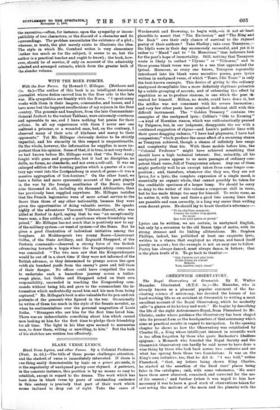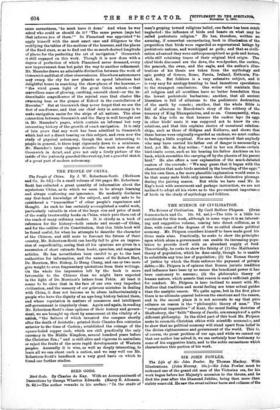GREENWICH OBSERVATORY.
The Royal Observatory at Greenwich. By E. Walter Maunder. Illustrated. (R.T.S. 5s.)—Mr. Maunder, who is already known as a pleasant popular exponent of the fas- cinating science of astronomy, has devoted the leisure of his hard-working life as an assistant at Greenwich to writing a most excellent account of the Royal Observatory, which he modestly calls "a glance at its history and work." He begins by describing the life of the eight Astronomers-Royal, from Flamsteed to Mr. Christie, under whose guidance the Observatory has been shaped into its present form as the headquarters of that astronomy which aims at practical results in regard to navigation. In the opening chapter he shows us how the Observatory was established by Charles II., a King whose intelligent interest in scientific work is too often forgotten by those who quote Rochester's libellous epigram : a Monarch who founded the Royal Society and the Greenwich Observatory can hardly be said never to have done a wise thing by those who look back across two centuries and see what has sprung from those two foundations. It was on the King's own initiative, too, that he did it. "I was told," writes Flamsteed, "that, my letters being shown King Charles, he started at the assertion of the fixed stars' places being false in the catalogue; said, with some vehemence, 'He must have them anew observed, examined, and corrected for the use of his seamen ; ' and further (when it was urged to him how necessary it was to have a good stock of observations taken for corr ecting the motions of the moon and the planets) with the same earnestness, he must have it done.' And when he was asked who could or should do it ? 'The same person (says he) that informs you of them." So Flamsteed was appointed "to apply himself with the most exact care and diligence to the rectifying the tables of the motions of the heavens, and the places of the fixed stars, so as to find out the so-much-desired longitude of places for the perfecting the art of navigation." Greenwich is still engaged on this work. Though it is now done with a degree of perfection of which Flamsteed never dreamed, every new improvement does but point the way to another refinement. Mr. Maunder draws an admirable distinction between the work of Greenwich and that of other observatories. Elsewhere astronomers ma), sweep the sky for new planets or spend laborious but delightful hours in searching the show-places of the heavens,— " the vivid green light of the groat Orion nebula — that marvellous mass of glowing, curdling, emerald cloud—or the in- describable magnificence of the myriad suns that cluster like swarming bees or the grapes of Eshcol in the constellation of Hercules." But at Greenwich they never forget that we are the first of sea-Powers, and that our chief duty in astronomy is to make navigation easier for the ships of all nations. The close connection between Greenwich and the Navy is well brought out in Mr. Maunder's pages, which contain an informal but very interesting history of the growth of exact navigation. It is only of late years that any work has been admitted to Greenwich which had not a direct bearing on this subject, and even now the study of physical astronomy, though the most interesting to people in general, is there kept rigorously down to a minimum. Mr. Maunder's later chapters describe the work now done at Greenwich in detail, and give not only a lively picture of the inside of the jealously guarded Observatory, but a graceful sketch of a great part of modern astronomy.























































 Previous page
Previous page